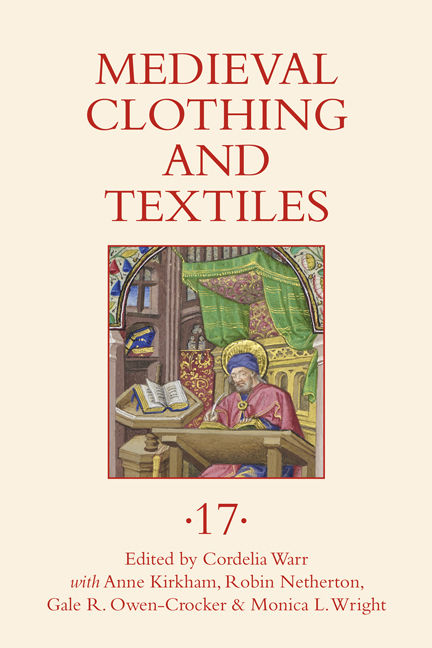Book contents
- Frontmatter
- Contents
- Illustrations
- Tables
- Contributors
- Acknowledgements
- Preface
- 1 Embroidered Beasts: Animals in the Bayeux Tapestry
- 2 The Sleeve from Bussy-Saint-Martin: A Rare Example of Medieval Quilted Armor
- 3 The Administration of Cloth and Clothing in the Great Wardrobe of Edward I
- 4 Hanging Together: Furnishing Textiles in a Fifteenth-Century Book of Hours
- 5 Gilt-leather Embroideries from Medieval Sweden and Finland
- 6 From Hennin to Hood: An Analysis of the Evolution of the English Hood Compared to the Evolution of the French Hood
- Recent Books of Interest
- Author Index, Volumes 1–16
5 - Gilt-leather Embroideries from Medieval Sweden and Finland
Published online by Cambridge University Press: 17 December 2023
- Frontmatter
- Contents
- Illustrations
- Tables
- Contributors
- Acknowledgements
- Preface
- 1 Embroidered Beasts: Animals in the Bayeux Tapestry
- 2 The Sleeve from Bussy-Saint-Martin: A Rare Example of Medieval Quilted Armor
- 3 The Administration of Cloth and Clothing in the Great Wardrobe of Edward I
- 4 Hanging Together: Furnishing Textiles in a Fifteenth-Century Book of Hours
- 5 Gilt-leather Embroideries from Medieval Sweden and Finland
- 6 From Hennin to Hood: An Analysis of the Evolution of the English Hood Compared to the Evolution of the French Hood
- Recent Books of Interest
- Author Index, Volumes 1–16
Summary
This article aims to shed light on extant preserved gilt-leather embroideries from Sweden and Finland, dating from the early fourteenth to the early sixteenth centuries. The first part of the article discusses the identification and classification of these embroideries, and examines systematically their fabrics, colors, sewing techniques, motifs, and component textual elements. The analysis informs conjecture about the dating and uses of the embroideries. The second part of the article describes a reconstruction project to re-create two large gilt-leather coverlets and reflects on the role of reconstruction as a valid and valuable research method for acquiring in-depth knowledge about historical textiles.
In Sweden and Finland there are a number of preserved medieval embroideries, which in the Middle Ages were referred to as “gilt-leather coverlets.” They are named after the thin strips of gilded leather that were characteristically used in these embroideries. Today, the terms intarsia embroidery or mosaic embroidery are commonly used to describe the underlying technique used in most of the gilt-leather embroideries. This involves cutting out the same motif from two squares of wool of different colors. The cut pieces are then exchanged for one another and whipstitched in place, in-filling the spaces in each ground fabric without any seam allowance. The result is two squares with the same motif, in inverted colors. Thin gilt-leather strips are couched down along the seams where the two colors meet. These leather strips, which lend to the embroidery its signature quality, gave rise to its name. Gilt-leather coverlets consist of a number of such squares, which have been joined by seams also covered in gilt-leather strips. The technique should not be confused with inlaid embroidery or with quilting. It is the couched gilt-leather stripping along with the joining technique and the imagery of the motifs that give these particular embroideries their own, distinctive visual character. Among the few extant medieval intarsia embroideries outside Scandinavia is the royal seal bag of King Edward I in the collections of Westminster Abbey. It is dated to 1280 and, according to Clare Browne and Michaela Zöschg, was made using the intarsia technique.
- Type
- Chapter
- Information
- Medieval Clothing and Textiles , pp. 116 - 143Publisher: Boydell & BrewerPrint publication year: 2023

